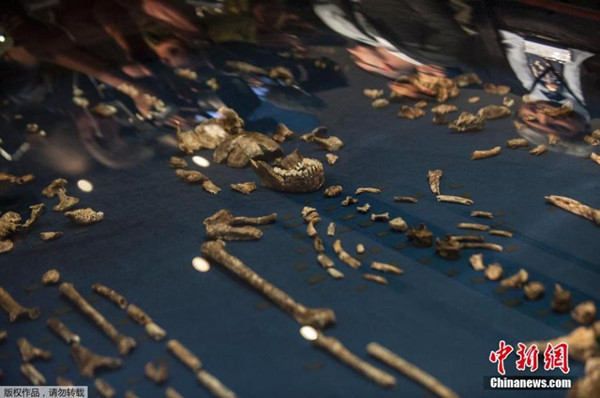
Fossils of a newly discovered ancient species, named "Homo naledi", are pictured during their unveiling outside Johannesburg September 10, 2015. (Photo/Agencies)
Scientists say they've discovered a new member of the human family tree, revealed by a huge trove of bones in a barely accessible, pitch-dark chamber of a cave in South Africa.
The creature shows a surprising mix of human-like and more primitive characteristics — some experts called it "bizarre" and "weird." The human relative also appeared to bury its dead.
Fossils of the creature were unearthed in a deep cave near the famed sites of Sterkfontein and Swartkrans, treasure troves 50 km (30 miles) northwest of Johannesburg that have yielded pieces of the puzzle of human evolution for decades.
And the discovery presents some key mysteries: How old are the bones? And how did they get into that chamber, reachable only by a complicated pathway that includes squeezing through passages as narrow as about 7 and a half inches (17.8 centimeters)?
The bones were found by a spelunker, and represent at least 15 individuals. The site has yielded some 1,550 specimens since its discovery in 2013.
Researchers named the creature Homo naledi (nah-LEH-dee). That reflects the "Homo" evolutionary group, which includes modern people and our closest extinct relatives, and the word for "star" in a local language. The find was made in the Rising Star cave system.
The creature, which evidently walked upright, represents a mix of traits. For example, the hands and feet look like Homo, but the shoulders and the small brain recall Homo's more ape-like ancestors, the researchers said.
Lee Berger, a professor at the University of the Witwatersrand in Johannesburg who led the work, said naledi's anatomy suggest that it arose at or near the root of the Homo group, which would make the species some 2.5 million to 2.8 million years old. The discovered bones themselves may be younger, said Berger.
At a news conference Thursday in the Cradle of Humankind, a site near the town of Magaliesburg where the discovery was made, bones were arranged in the shape of skeleton in a glass-covered wooden case. Fragments of small skulls, an almost complete jawbone with teeth, and pieces of limbs, fingers and other bones were arrayed around the partial skeleton.
"Ladies and gentlemen I am pleased to introduce you to a new species of human ancestor. A new species …he is pretty, he is worth applause isn't he. A new species within our very genus, a species that we have called Homo Naledi, Naledi meaning star," Berger told those gathered for the unveiling.
Berger handed a skull reconstruction to Deputy President Cyril Ramaphosa, who kissed it, as did other VIPs. Berger beamed throughout the unveiling.
"This chamber really gives us a window of understanding our past, beginning to gain more knowledge about our present moment and also gives us an insight of what our future could look like. For us to understand how this species lived right here in South Africa, right here on the African continent is something that is a great, great step for us. And one could echo what was once said that this could well be a small step for naledi, naledi took a small step into that chamber but for us, as the people of the world, this is a gigantic step to understand who we are," he said.
The researchers also announced the discovery in the journal eLife. They said they were unable to determine an age for the fossils because of unusual characteristics of the site, but that they are still trying.
Berger said researchers are not claiming that naledi was a direct ancestor of modern-day people, and experts unconnected to the project said they believed it was not.


















































